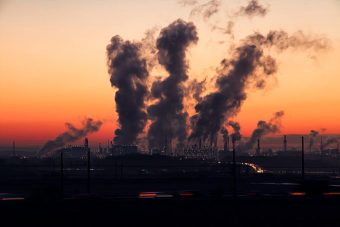
Global emissions of climate-warming carbon dioxide remained static in 2016, a welcome sign that the world is making at least some progress in the battle against global warming by halting the long-term rising trend.
All of the world’s biggest emitting nations, except India, saw falling or static carbon emissions due to less coal burning and increasing renewable energy, according to data published on Thursday by the Netherlands Environmental Assessment Agency (NEAA). However other mainly developing nations, including Indonesia, still have rising rates of CO2 emissions.
Stalled global emissions still means huge amounts of CO2 are being added to the atmosphere every year – more than 35bn tonnes in 2016 – driving up global temperatures and increasing the risk of damaging, extreme weather. Furthermore, other heat-trapping greenhouse gases, mainly methane from cattle and leaks from oil and gas exploration, are still rising and went up by one per cent in 2016.
“These results are a welcome indication that we are nearing the peak in global annual emissions of greenhouse gases,” said climate economist Prof Lord Nicholas Stern at the London School of Economics and president of the British Academy.
“To realise the goals of the Paris agreement and hold the increase in global average temperature to well below 2C, we must reach peak emissions as soon as possible and then achieve a rapid decline soon afterwards,” Stern said. “These results from the Dutch government show that there is a real opportunity to get on track.”
Jos Olivier, the chief researcher for the NEAA report, sounded a note of caution: “There is no guarantee that CO2 emissions will from now on be flat or descending.” He said, for example, a rise in gas prices could see more coal burning resume in the US.
The flat CO2 emissions in 2016 follow similar near-standstills in 2014 and 2015. This lack of growth is unprecedented in a time when the global economy is growing. As the number of years of flat emissions grows, scientists are more confident a peak has been reached, rather than a temporary halt. In July 2016, senior economists said China’s huge coal burning had peaked, marking a historic turning point in efforts to tame climate change.
Stern said many of the big emitting nations had achieved significant reductions in 2016: “However, all countries have to accelerate their emissions reductions if the Paris goals are to be met.” He said this could also drive development in poorer nations: “We can now see clearly that the transition to a low-carbon economy is at the heart of the story of poverty reduction and of the achievement of the UN Sustainable Development Goals.”
The new Dutch report shows CO2 emissions from China, the world’s biggest emitter, fell 0.3 per cent in 2016. US CO2 emissions fell 2.0per cent and Russia’s by 2.1 per cent, with the EU flat, although UK emissions tumbled by 6.4 per cent, as coal burning plunged.
Of the top five emitters, only India’s CO2 emissions rose, by 4.7 per cent. Significant increases were also seen in Indonesia, Malaysia, the Philippines, Turkey and Ukraine.
However, over a quarter of the warming effect seen by the world comes from non-CO2 greenhouse gases, with methane by far the most significant. Cattle belch the gas and are responsible for 23 per cent of global methane emissions, and this source rose by 0.4 per cent in 2016. Scientists have warned that the growing global appetite for meat, especially beef, cannot continue if climate change is to be kept under 2C.
Another quarter of methane emissions come from fossil fuel production and leaks in gas distribution pipes. Since 2000, emissions from coal and gas production have grown by more than 65.
Carbon emissions from forest destruction and other land use changes were not included in the main analysis as they are more difficult to estimate and vary strongly from year to year.
Source: businessgreen.com



